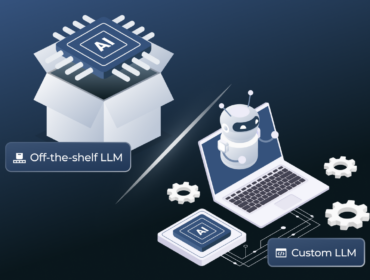Today’s cryptocurrencies run on various blockchain networks based on technology such as Ethereum, Binance Smart Chain, Algorand, Avalanche, Cosmos, Polkadot, Tezos, Solana, and others. Each blockchain is unique, with its own features and functions. Most of them work according to different algorithms and rules for reaching consensus. And while bridges exchange data between other blockchains, a general lack of interoperability has become a persisting problem for a growing number of DeFi networks.
So how does cross-chain DeFi allow you to take the best aspects of these blockchain platforms and implement them into your own?
What is Cross-chain DeFi Technology?
Cross-chain DeFi technology allows for the easy and quick exchange of information between blockchains. This helps create a network of connected blockchains, eliminating their isolated nature.
The DeFi ecosystem itself is unable to streamline multi-chain smart contract transactions. Cross-chain DeFi technology solves this problem by facilitating the interoperability between blockchain networks through parachains and bridges.
The objectives of the technology are to promote interoperability between blockchain networks, swap coins or tokens, and provide censorship resistance.
The Benefits of Cross-chain Bridges for DeFi users
Bridges continue to prove their value for the DeFi ecosystem. They not only benefit end users but are also beneficial to the entire cryptocurrency ecosystem.
- Bridges provide flexibility – They allow users to transfer assets and valuable data from one blockchain to another. Users can access the benefits of various blockchain technologies without being limited by the capabilities of one particular chain.
- Cross-chain Enforcement – Using cross-chain bridges, users can reap all the benefits of a particular blockchain. One of the most popular scenarios is Bitcoin users enjoying DeFi features on the Ethereum blockchain. Bitcoin on Ethereum becomes Wrapped Bitcoin (WBTC), an ERC20 token, where BTC holders can trade in the well-established DeFi ecosystem and earn rewards.
- Interactions between blockchains – Bridges make interactions between individual blockchains possible via a connection between the L1 main chain (parent chain) and L2 chain (child chain). This allows developers to embed and run DApps on DeFi platforms (such as rollups built on Ethereum).
- Scalability – Bridges in DeFi significantly improve network scalability. This is possible because a bridge creates a connection between the primary and secondary chains, allowing for the bulk of transactions to occur across its ecosystem.
- Efficiency – With bridges, users can move their assets from a non-scalable blockchain to a high-performance blockchain and enjoy the benefits of low gas fees while taking advantage of the power of Ethereum smart contracts. They can even make fast microtransactions on-chain without worrying about high fees.
Issues with Cross-Chain Bridges
Cross-chain DeFi isn’t without its flaws. During development, it is critical to keep specific issues top of mind.
- Single Points of Failure/Centralization
Centralized cross-chain bridges rely on one administrator or a small group of entities that manage the minting and burning of tokens. This means that one specific group of “guardians” are responsible for:
- Holding assets
- Notifying the bridge of a transaction
- Verifying transactions
- Minting and burning wrapped tokens
Because of centralization, users have to rely on one group of validators. There is a minimal chance that reputable companies like Binance will steal your funds. However, breaching a central node or permissioned network and taking over the blockchain bridge by hackers has become a more common problem.
There are two types of bridges: custodial (centralized or trusted) and non-custodial (decentralized or trustless). They differ in who holds the coins. In order to eliminate the issue of centralization, users should opt for non-custodial bridges.
- Poor Liquidity
Not all cross-chain bridges provide liquidity. In order to be truly liquid, a bridge should have asset pools on native and non-native blockchains to streamline the lock-mint-burn-release process.
Centralized bridges have higher liquidity because the controlling entity has incentives to store pools of assets across multiple platforms. However, with decentralized bridges, users are less incentivized to keep funds locked on different blockchains. In this case, the process of exchanging assets is a more complicated one.
- Security Issues
In order to avoid relying on intermediaries, decentralized bridges use smart contracts to manage asset swaps.
Despite all the convenience, smart contracts have their flaws. Their security depends on how secure developers make them. Many cross-chain bridges rely on the integrity of the code of a smart contract. If the code is written poorly, smart contracts are vulnerable to malicious exploits.
Even decentralized bridges are not completely safe. The $320 million hack on Wormhole (a Solana-Ethereum bridge) back in February 2022 demonstrated that decentralized protocols are not completely secure.
Best Crypto Bridges in the DeFi Industry

In the past few years, major blockchains in DeFi have built bridges between networks to meet the growing need for interoperability within the industry. Here are some of the most popular ones:
- Portal Token Bridge (formerly Wormhole)
- Binance Bridge
- Avalanche Bridge
- Tezos Wrap Protocol Bridge
- Synapse Bridge
- Bitcoin Cash SmartBCH Bridge
- Fantom AnySwap Bridge
The complexity of Creating a Cross-Chain Bridge
The explosion in popularity of cross-chain bridges should not mislead you – their development is not an easy task that any team can master.
- It is necessary to develop smart contracts (and audit and test them) for two blockchains at once, which may have nothing in common. And if you want to create a full-fledged cross-chain platform, many bridges will be required.
- Blockchains can have interoperability complexities that can make something as simple as issuing a call to a contract to release/unlock tokens a difficult task.
- You will need an external oracle to confirm transactions and do it with 100% reliability.
- It is necessary to ensure the stable communication and compatibility of every component.
- It is necessary to ensure energy efficiency and the economic justification for all operations.
In short, developing your cross-chain bridge from scratch is an extremely complex and time-consuming task requiring a team of DeFI exchange development specialists.
How to Create a Cross-chain DeFi Platform?
Today, many cross-chain protocols that can be adapted to the needs of any cross-chain platform are available on the network. One of the most popular is Chainbridge, which allows you to deploy a bridge between two EVM-compatible blockchains. However, it has no fundamental differences from other “build your own cross-chain bridge” kits.
To start building your bridge, you’ll need to:
- Deploy bridge smart contracts on both blockchains (usually supplied in a package but requires adaptation and testing).
- Deploy a set of so-called Handler contracts on both blockchains. These smart contracts tell the main bridge contracts precisely what to do with a particular token. Each token standard (and each coin that does not meet these standards) needs its own Handler contract. Most bridge templates contain, at best, an ERC-20 Handler. If you want to work with other tokens, you will have to write the Handler yourself or look for it on the side.
- Deploy an oracle system and integrate it with bridge contracts. The suppliers of ready-made cross-chain protocol packages transfer this responsibility to the end developers.
- And finally, you need to carefully test the finished bridge and ensure there are no vulnerabilities and bugs.
What are the prospects for cross-chain platforms?
Given the rapid development of the DeFi industry, we can observe that the boom of cross-chain platforms will continue. However, the need to ensure interactions between blockchains will only grow, and consequently, the need for cross-chain solutions will also increase.
Still, there aren’t so many reliable cryptocurrency exchanges available, meaning that more people will continue to create more exchanges. Unicsoft’s expertise in developing DeFI exchange platforms and blockchain solutions has made it the ideal partner for businesses looking to establish a foothold in the market.





![How to Create a Cross-chain DeFi Platform What’s the EU Artificial Intelligence Act and How to Comply? [Webinar]](https://unicsoft.com/wp-content/uploads/2024/03/Cover_1140_v1.1-370x280.png)

